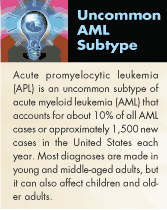Arsenic Improves Outcomes of Newly Diagnosed APL Pts
A phase III trial has shown that using arsenic trioxide (Trisenox) after standard first-line chemotherapy for acute promyelocytic leukemia (APL) significantly improves event-free survival and provides better overall survival, compared to standard therapy alone.
• BETHESDA, MarylandA phase III trial has shown that using arsenic trioxide (Trisenox) after standard first-line chemotherapy for acute promyelocytic leukemia (APL) significantly improves event-free survival and provides better overall survival, compared to standard therapy alone. The National Cancer Institute released a summary of the results from the study, which it sponsored, to make oncologists and patients aware of the potential benefits of arsenic trioxide in treating newly diagnosed APL.
"These results indicate that arsenic trioxide should be considered as part of the initial treatment of patients with acute promyelocytic leukemia," said study co-author Richard Larson, MD, of the University of Chicago.
About 70% of APL patients treated with standard chemotherapy regimens attain complete remission, and 35% to 45% achieve 5-year, recurrence-free survival. In recent years, APL treatment has improved with the addition of all-trans-retinoic acid, or ATRA (tretinoin, Vesanoid), to standard chemotherapy, and recent studies have found that arsenic trioxide can produce a second remission in relapsed or recurrent APL patients. Both Vesanoid and Trisenox are approved for treating APL.
From June 1999 to March 2005, five NCI-supported Cooperative Oncology Groups, led by the Cancer and Leukemia Group B, enrolled 582 newly diagnosed APL patients aged 15 years and older in a multicenter, randomized, controlled, phase III trial. Bayard Powell, MD, of Wake Forest University School of Medicine, served as principal investigator.

The control group received a standard regimen of tretinoin twice daily, daunorubicin for 4 days, and cytarabine for 7 days, followed by a standard postremission treatment of two more courses of tretinoin plus daunorubicin.
The experimental group received the same standard treatment but with the addition of two 25-day courses of intravenous arsenic trioxide. This therapy started as soon as a patient experienced a complete or partial remission and before the standard postremission regimen began. Arsenic trioxide was delivered on an outpatient basis for 2 hours daily, Monday through Friday, for 5 weeks. Those who remained free of visible disease received another year of oral chemotherapy to prevent relapse.
Three years after diagnosis, 77% of patients in the experimental arm remained alive and in remission, compared with 59% in the control group, a highly significant statistical difference. The experimental group also had a better overall survival at 3 years86% vs 77% in the control arm.
There were no differences in hematologic toxicities between the two groups, but the experimental group had a slightly higher incidence of headache and infection. Complete results from the trial will be presented at the American Society of Clinical Oncology meeting in June.
Newsletter
Stay up to date on recent advances in the multidisciplinary approach to cancer.